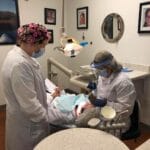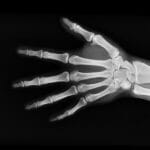This guide explores the coronal plane, a fundamental concept in anatomy. We’ll delve into its definition, significance in medical imaging, clinical applications, and ongoing research.
Decoding the Coronal Plane
The coronal plane, also known as the frontal plane, is an imaginary vertical plane that dissects the body into anterior (front) and posterior (back) sections. Imagine a sheet of glass slicing through you from head to toe, separating your front and back – that’s the coronal plane. This concept is foundational to understanding anatomical location, describing movement, and interpreting medical images. Dr. Nikhil, an anatomy expert, explains: “In anatomy, a coronal plane is an imaginary plane that divides the body into two halves, with one half being anterior (front) to the plane and the other half being posterior (back) to the plane.” This division is always in reference to the anatomical position – standing upright, palms forward.
Why is Anatomical Position Important?
Anatomical position provides a standardized reference point. Without it, anterior and posterior could become confusing depending on how the body is oriented. Imagine someone lying face down – their back is facing upwards, but anatomically, it’s still the posterior aspect. Maintaining a consistent reference point (anatomical position) ensures clarity in anatomical descriptions.
Coronal Plane and Movement
Think about all the movements you perform sideways, such as jumping jacks or cartwheels. These actions occur within the coronal plane. Specific examples of coronal plane movements include:
- Abduction: Moving a limb away from the midline of your body (raising your arms to the side).
- Adduction: Moving a limb towards the midline (lowering your arms back down).
- Lateral Flexion: Bending your spine sideways.
As Healthline (July 11, 2023) states, “What movements happen in the coronal (frontal) plane? The coronal plane, often referred to as the frontal plane, divides the body into the front (anterior) and back (posterior)…”. This understanding of movement within the coronal plane is crucial for analyzing athletic performance, diagnosing movement disorders, and designing rehabilitation programs.
The Coronal Plane in Healthcare
The coronal plane plays a critical role in various healthcare applications, particularly in medical imaging and surgical planning.
Coronal Plane Imaging: Seeing Inside the Body
Medical imaging technologies, such as CT scans, MRI, and PET scans, produce cross-sectional images. The coronal plane is essential for interpreting these images. It allows healthcare professionals to visualize internal structures from a front-to-back perspective, much like looking at the cut side of a piece of fruit. This view is essential for:
- Diagnosis: Identifying injuries, diseases, and abnormalities (fractures, tumors, etc.).
- Treatment Planning: Guiding interventions and surgical approaches.
- Monitoring: Tracking the progression of diseases or the healing process.
Clinical Applications across Specialties
The coronal plane is instrumental in several medical specialties:
- Neurology: Coronal brain sections are vital for identifying strokes, tumors, and other neurological conditions.
- Orthopedics: Examining joint alignment, diagnosing fractures, and evaluating scoliosis.
- Cardiology: Visualizing the heart’s chambers and major vessels.
- Abdominal Imaging: Assessing organs like the liver, kidneys, and spleen.
Surgical Planning: Precision Through Visualization
Surgeons rely heavily on coronal plane images during pre-operative planning. This perspective allows them to:
- Visualize Target Area: Accurately locate the surgical site.
- Map Surrounding Structures: Understand the relationship between the target area and critical anatomical features.
- Plan Incisions: Determine the optimal incision location and minimize damage to surrounding tissues.
Coronal Plane Imaging: Techniques and Applications
Coronal plane imaging provides unparalleled anatomical detail in assessing various body regions, enabling precise diagnoses and informed treatment decisions.
Specific Anatomical Regions:
- Head and Face: Assessment of orbits, lens, and facial structures, crucial for diagnosing facial trauma and orbital diseases.
- Shoulder: Visualization of the labrum, AC joint, rotator cuff tendons, essential for diagnosing shoulder injuries.
- Uterus: 3D coronal reconstructions aid in diagnosing gynecological disorders like fibroids and polyps.
- Cranium: Assessing arterial and venous patency and identifying vascular abnormalities.
- Optic Nerve: Visualizing optic nerve diameter and subarachnoid space to diagnose optic nerve lesions.
Advanced Techniques
- MRI (Shoulder): Coronal oblique planes optimize specific shoulder structure visualization.
- CT (IPF): Coronal plane reconstructions aid in assessing idiopathic pulmonary fibrosis.
- 3D Reconstruction (Uterus): Enhanced anatomical detail for improved gynecological diagnoses.
- Color Doppler Ultrasound (Cranial): Assessing blood flow and vessel patency.
Coronal Plane vs. Other Imaging Planes
Medical imaging employs three primary anatomical planes:
- Coronal (Frontal): Divides the body into front and back.
- Sagittal: Divides the body into left and right.
- Axial (Transverse): Divides the body into top and bottom.
Radiologists use a combination of these planes for comprehensive assessments.
Pushing the Boundaries: Ongoing Research
Research continues to refine our understanding of the coronal plane’s role in diagnostics, treatment, and research. Some areas of ongoing exploration include:
- Movement Analysis: Investigating how coronal plane movements can predict athletic injuries.
- 3D Visualization: Utilizing 3D reconstructions from multiple coronal slices to enhance diagnostic capabilities.
- AI-Assisted Image Analysis: Developing AI algorithms to analyze coronal plane images and assist in diagnosis.
Beyond the Basics
The coronal plane isn’t just a static anatomical concept; it’s a powerful tool that unlocks insights into how we move, how our bodies function, and what goes wrong when we’re ill. Are you curious about testing your knowledge of convolutional neural networks quiz? Thinking about converting units? Our converter tool makes it simple! Quickly and easily convert 74.4 kg to pounds. As research progresses, the coronal plane likely holds further clues to understanding human health and disease. This ongoing exploration promises to reveal even more about our complex anatomy and improve medical care.
- China II Review: Delicious Food & Speedy Service - April 17, 2025
- Understand Virginia’s Flag: History & Debate - April 17, 2025
- Explore Long Island’s Map: Unique Regions & Insights - April 17, 2025

















2 thoughts on “Understanding the Coronal Plane: A Comprehensive Guide to Anatomy, Imaging, and Clinical Applications”
Comments are closed.